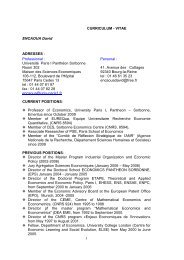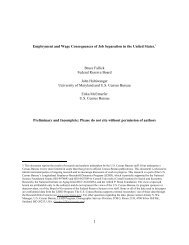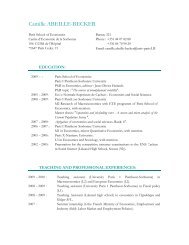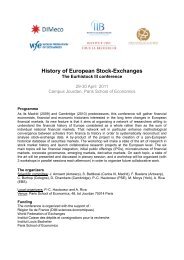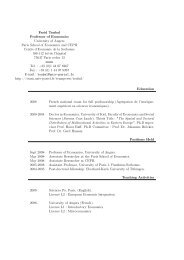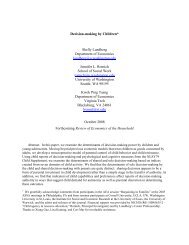info document - Paris School of Economics
info document - Paris School of Economics
info document - Paris School of Economics
Create successful ePaper yourself
Turn your PDF publications into a flip-book with our unique Google optimized e-Paper software.
ate, ¯τ(y), for 50%, 75%, 100%, 125%, 150%, 175% and 200% <strong>of</strong> AW. One possible approachwould be to approximate these data points with a flexible functional form, which can thenserve as the average tax schedule for the relevant country. It turns out however that thisapproach does not always produce sensible results for the tax schedule for income levelsmuch beyond 200% <strong>of</strong> AW, which is relevant when individuals solve their dynamic program.Fortunately, there is another piece <strong>of</strong> <strong>info</strong>rmation available from OECD that allows us toovercome this difficulty. Specifically, we also have the top marginal tax rate and the topbracket corresponding to it for each country. As described in more detail in the appendix,we use this <strong>info</strong>rmation to generate average tax rates at income levels beyond two timesAW. Then we fit the following smooth function to the available data points:where AW is the average wage earnings.¯τ(y/AW ) = a 0 + a 1 (y/AW ) + a 2 (y/AW ) nThe parameters <strong>of</strong> the estimated average tax functions for all countries are reported inTable 3, along with the R 2 values. Although the assumed functional form allows for variouspossibilities, all fitted tax schedules turn out to be increasing and concave in the relevantregions (up to 10 times AW). The lowest R 2 is 0.984 and the mean is 0.991 indicating a fairlygood fit. In figure 1 we plot the estimated functions for three countries: the least progressive(United States), the most progressive (Finland), and one with intermediate progressivity(Germany).Figure 2 plots the progressivity wedges for the eight countries in our sample. Specifically,each line plots P W (0.5, 0.5n) for n = 1, 2, .., 6, which are essentially the wedges faced byan individual who starts life at half the average earnings in that country and looks towardsan eventual wage level that is up to six times his initial wage. As seen in the figure,countries are ranked in terms <strong>of</strong> their progressivity consistent with one might conjecture.US and UK have the least progressive tax system, whereas Scandinavian countries have themost progressive one, with larger continental European countries scattered between thesetwo extremes. The differences also appear quantitatively large (although a more preciseevaluation needs to await for the full-blown model in Section X): for example, a youngworker who earns half the average wage today and aims to earn two times the average wage(n = 4) in the future loses about 12% <strong>of</strong> his before-tax wage in the US and UK comparedto 26% in Denmark and Finland. These differences grow with the ambition level <strong>of</strong> theindividual, dampening the incentives to accumulate human capital especially at the top <strong>of</strong>the distribution.9




